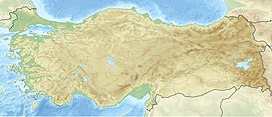Karaca Dağ
| Karaca Dağ | |
|---|---|
 Karapınar; Looking east on Karacadağ Mountains (2,030 m), a volcanic crater mountain, 2012 | |
| Highest point | |
| Elevation | 1,957 m (6,421 ft) |
| Coordinates | 37°40′12″N 39°49′48″E / 37.67000°N 39.83000°E |
| Geography | |
| Geology | |
| Mountain type | Shield volcano |
| Last eruption | Unknown |
Karaca Dağ (Kurdish: قهرهژداخ, Qerejdax) is a shield volcano located in eastern Turkey.[1]
It was also known as Mount Masia.[2] Which in turn was used to give the title of an iris found on the mountain, as Iris masia.[3]
On 6 March 2006, Der Spiegel reported that the Max Planck Institute for Plant Breeding Research in Cologne[4] had discovered that the genetically common ancestor of 68 contemporary types of cereal still grows as a wild plant on the slopes of Mount Karaca (Karacadag).[5] The results strongly suggest that slopes of Karaca Dağ provided the site for the first domestication of einkorn wheat approximately 9,000 years ago.
The area of Karaca Dağ was gifted to Ertuğrul Gazi by the Seljuk Sultan of the Sultanate of Rum, Sultan Kayqubad I, after bravely fighting in the Battle of Yassıçemen.
See also
References
- ^ "Karaca Dag". Global Volcanism Program. Smithsonian Institution.
- ^ Phillips, Roger; Rix, Martyn (1991). Perennials Vol. 1. Pan Books Ltd. p. 216. ISBN 9780330327749.
- ^ Pries, Bob (28 November 2013). "(SPEC) Iris masia Stapf ex Fos". wiki.irises.org (American Iris Society). Retrieved 24 November 2014.
- ^ Max Planck Institute for Breeding Research
- ^ Heun, Manfred; et al. (November 1997). "Site of Einkorn Wheat Domestication Identified by DNA Fingerprinting" (PDF). Science. 278 (5341): 1312–1314. Bibcode:1997Sci...278.1312H. doi:10.1126/science.278.5341.1312. Archived from the original (PDF) on 2006-12-31. Retrieved 2010-08-29.

